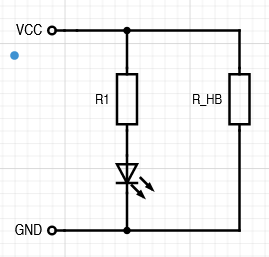I was changing the control board of my 3D printer. When testing the heatbed, I saw that the LED wasn't glowing (as with the old control board), when the heatbed was turned on. So I investigated with my multimeter.
The circuit is pretty simple (taken from the prusa3d GitHub, the wire on the right stands for the heating loops on the PCB).
So more appropriately would be:
Here my observations (during a long period, so there should be no PWM):
- The heatbed warms up in a timely manner
- Measured the voltage drop between the contacts (VCC to GND: 11.36 V)

- Measured the voltage drop across R1 (VCC 10.36 V to pad of R1 towards D1)
- Measured the voltage drop across D1 (-2 V, both pads of the diode, however the value varies)

- I checked the function of the diode with the diode setting on the multimeter
I understand that the diode won't glow with a negative voltage, but why is the measured voltage negative?


